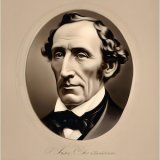Under the Willow-Tree Page #2
"Under the Willow-Tree" is a sentimental tale by renowned author Hans Christian Andersen. This children's novel portrays the story of Knud, a gardener's boy who falls in love with a girl named Joanna. They play together under a willow tree, and their friendship grows into love. But when Joanna is sent off to school and eventually marries another man, Knud is devastated. His heartache, however, propels him to travel, encounter new experiences, and learn about life and love. The narrative emphasizes the impermanence of romantic love and the possibilities for self-growth and self-discovery that come from enduring sorrow.
Genre: Children
Genre: Children
- 24 Views
children cried about it; but afterwards, thinking very probably that the poor lover ought not to be left alone in the world, they ate him up too: but they never forgot the story. The two children still continued to play together by the elder-tree, and under the willow; and the little maiden sang beautiful songs, with a voice that was as clear as a bell. Knud, on the contrary, had not a note of music in him, but knew the words of the songs, and that of course is something. The people of Kjoge, and even the rich wife of the man who kept the fancy shop, would stand and listen while Joanna was singing, and say, "She has really a very sweet voice." Those were happy days; but they could not last forever. The neighbors were separated, the mother of the little girl was dead, and her father had thoughts of marrying again and of residing in the capital, where he had been promised a very lucrative appointment as messenger. The neighbors parted with tears, the children wept sadly; but their parents promised that they should write to each other at least once a year. After this, Knud was bound apprentice to a shoemaker; he was growing a great boy, and could not be allowed to run wild any longer. Besides, he was going to be confirmed. Ah, how happy he would have been on that festal day in Copenhagen with little Joanna; but he still remained at Kjoge, and had never seen the great city, though the town is not five miles from it. But far across the bay, when the sky was clear, the towers of Copenhagen could be seen; and on the day of his confirmation he saw distinctly the golden cross on the principal church glittering in the sun. How often his thoughts were with Joanna! but did she think of him? Yes. About Christmas came a letter from her father to Knud's parents, which stated that they were going on very well in Copenhagen, and mentioning particularly that Joanna's beautiful voice was likely to bring her a brilliant fortune in the future. She was engaged to sing at a concert, and she had already earned money by singing, out of which she sent her dear neighbors at Kjoge a whole dollar, for them to make merry on Christmas eve, and they were to drink her health. She had herself added this in a postscript, and in the same postscript she wrote, "Kind regards to Knud." The good neighbors wept, although the news was so pleasant; but they wept tears of joy. Knud's thoughts had been daily with Joanna, and now he knew that she also had thought of him; and the nearer the time came for his apprenticeship to end, the clearer did it appear to him that he loved Joanna, and that she must be his wife; and a smile came on his lips at the thought, and at one time he drew the thread so fast as he worked, and pressed his foot so hard against the knee strap, that he ran the awl into his finger; but what did he care for that? He was determined not to play the dumb lover as both the gingerbread cakes had done; the story was a good lesson to him.
Translation
Translate and read this book in other languages:
Select another language:
- - Select -
- 简体中文 (Chinese - Simplified)
- 繁體中文 (Chinese - Traditional)
- Español (Spanish)
- Esperanto (Esperanto)
- 日本語 (Japanese)
- Português (Portuguese)
- Deutsch (German)
- العربية (Arabic)
- Français (French)
- Русский (Russian)
- ಕನ್ನಡ (Kannada)
- 한국어 (Korean)
- עברית (Hebrew)
- Gaeilge (Irish)
- Українська (Ukrainian)
- اردو (Urdu)
- Magyar (Hungarian)
- मानक हिन्दी (Hindi)
- Indonesia (Indonesian)
- Italiano (Italian)
- தமிழ் (Tamil)
- Türkçe (Turkish)
- తెలుగు (Telugu)
- ภาษาไทย (Thai)
- Tiếng Việt (Vietnamese)
- Čeština (Czech)
- Polski (Polish)
- Bahasa Indonesia (Indonesian)
- Românește (Romanian)
- Nederlands (Dutch)
- Ελληνικά (Greek)
- Latinum (Latin)
- Svenska (Swedish)
- Dansk (Danish)
- Suomi (Finnish)
- فارسی (Persian)
- ייִדיש (Yiddish)
- հայերեն (Armenian)
- Norsk (Norwegian)
- English (English)
Citation
Use the citation below to add this book to your bibliography:
Style:MLAChicagoAPA
"Under the Willow-Tree Books." Literature.com. STANDS4 LLC, 2024. Web. 14 May 2024. <https://www.literature.com/book/under_the_willow-tree_2255>.




Discuss this Under the Willow-Tree book with the community:
Report Comment
We're doing our best to make sure our content is useful, accurate and safe.
If by any chance you spot an inappropriate comment while navigating through our website please use this form to let us know, and we'll take care of it shortly.
Attachment
You need to be logged in to favorite.
Log In